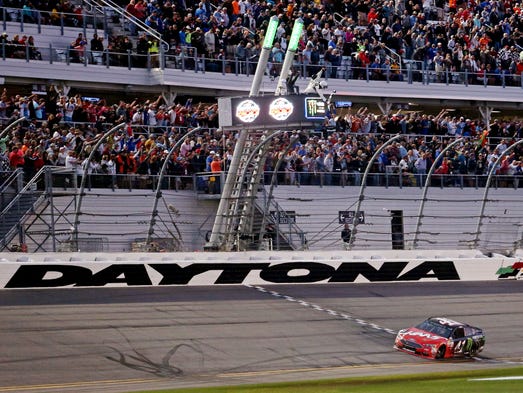James: Losing Target sponsorship shows NASCAR is falling behind pack – USA TODAY

USA TODAY Sports’ Brant James looks ahead to some of the top story lines fans should keep an eye on at the Overton’s 400 in the Poconos this Sunday.
USA TODAY Sports
NASCAR fans were irritated at the inconvenience of having to trawl their cable lineup for the Eldora Speedway Camping World Truck Series race. That the popular novelty had been relegated to FOX Business stung a bit more because Fox Sports aired the United States-El Salvador Gold Cup soccer match on FS1 instead.
Outrage. Those kickers in short pants taking precedent over racing.
Target’s announced decision to not renew its partnership with Chip Ganassi Racing’s NASCAR program puts the world’s game ahead two-nil in the span of 10 days.
On multiple levels, this must be disconcerting for racing as an industry. It continues, after all, to learn the new business paradigm since the economic downturn of the late 2000s coincided with, and was partially spurred by, a downturn in the consumption of the sport.
MORE NASCAR STORIES:
Consider what Target left last season in Ganassi’s Scott Dixon, a four-time IndyCar series champion who is methodically mounting the stratosphere of open-wheel racing’s all-time wins list. With 41, he’s one away from third, trailing A.J. Foyt (67), Mario Andretti (52) and Michael Andretti (42).
Target’s decision to leave Ganassi’s open-wheel team ended a 27-year relationship in that form of racing after its ubiquitous red with white logo underwrote Ganassi in winning 11 championships and the Indianapolis 500 four times.
And consider what Target will leave after 2017: Kyle Larson, who turns 25 on Monday, is a burgeoning NASCAR superstar who has established himself as a legitimate championship contender this season.
Entering the 21st race of the season this weekend at Pocono Raceway, he’s won twice and is second in driver points, 48 behind Martin Truex Jr. After Target scaled back its sponsorship of Larson this season, there was hope that performance could salvage the sponsorship for the No. 42 Chevrolet.
Larson did his part. It did not matter.
PHOTOS: KYLE LARSON THROUGH THE YEARS
And why did Target end its 16-year relationship with Ganassi’s NASCAR team? According to a statement provided by the company, a large part of the reasoning was soccer. The Minneapolis-based retail chain in January announced a sponsorship deal to emblazon its logo across the chest of its local Major League Soccer franchise — Minnnesota United FC — and become a league corporate partner.
According to a Jan. 19, 2017 Forbes article, Heineken’s corporate deal with the MLS was worth $50 million over five years. That can buy a lot of speed for a couple cars in modern NASCAR. Jersey sponsorships typically are valued from $2-5 million. Target also has naming rights to the venues for Minnesota’s Major League Baseball and NBA/WNBA venues.
“As we looked to evolve our sports marketing program, soccer provided Target with a unique opportunity to reach our guests in new places, and at all levels of the sport,” the company said through a statement. “Through partnerships with Major League Soccer, Minnesota United FC, U.S. Youth Soccer and the U.S. Soccer Foundation, Target has been able to create meaningful connections with players, fans and families, no matter how they participate in the sport.”
Target CEO Brian Cornell will be pilloried for the decision within the NASCAR industry. Critics will espouse the potential and quality Larson has demonstrated. They’re right. They’ll lament how great the racing product is. It doesn’t matter.
And they’ll wonder why corporate executives don’t love their niche sport as much as they do, when really the question is why don’t they find it as lucrative as they did before Fortune 500 companies either began leaving or spending much less on racing. Some of those questions answer themselves.
According to Nielsen’s media-evaluation “Sport24” program, Target was the most valuable primary sponsor at the midway point of the season, with all sponsors associated with Larson’s car valued at $111 million. It was the first time in the history of the research that Jimmie Johnson’s Lowe’s sponsor was not the most productive. And still it wasn’t enough.
Debates will fire about what soccer can learn from racing. Ninety minutes is a fine amount of sports entertainment. Kids these days are playing a lot of “FIFA 17” and not so much into cars. Kids.
And there will be numbers, so many numbers comparing television audiences, demographics, including the average Target shopper’s profile — median age, 40; median household income, approximately $64,000; approximately 43% have children at home; about 57% have completed college — and why that does or doesn’t work with NASCAR’s fanbase.
In a statement, Ganassi said “Kyle Larson is a once in a generation talent, he and the No. 42 Chevrolet will still be on the track for a long time, the only difference is that they will have different colors.”
All verifiable, but that doesn’t make the next phase any easier for his team — even though it is encouraged by queries already — or less disconcerting for NASCAR. Not in a series where Fortune 500, full-time benefactors are rare and consistent winners such as Hendrick Motorsports have had to hustle to parcel together sponsorship for NASCAR’s 14-time most popular driver, Dale Earnhardt Jr.
That’s in addition to mainstream crossover personality Danica Patrick experiencing severe sponsorship problems at Stewart-Haas Racing, and a title sponsor for the sport’s top series not being secured until December — and at a figure way closer to the cost of a competitive Cup team than the deal Sprint left.
For a sport that once considered only the NFL its superior, this soccer business is going to sting. But it’s just another signal than any recover of the golden times is going to require more than indignation.
Follow James on Twitter @brantjames
GALLERY: BEST SHOTS FROM 2017 NASCAR CUP SERIES










































